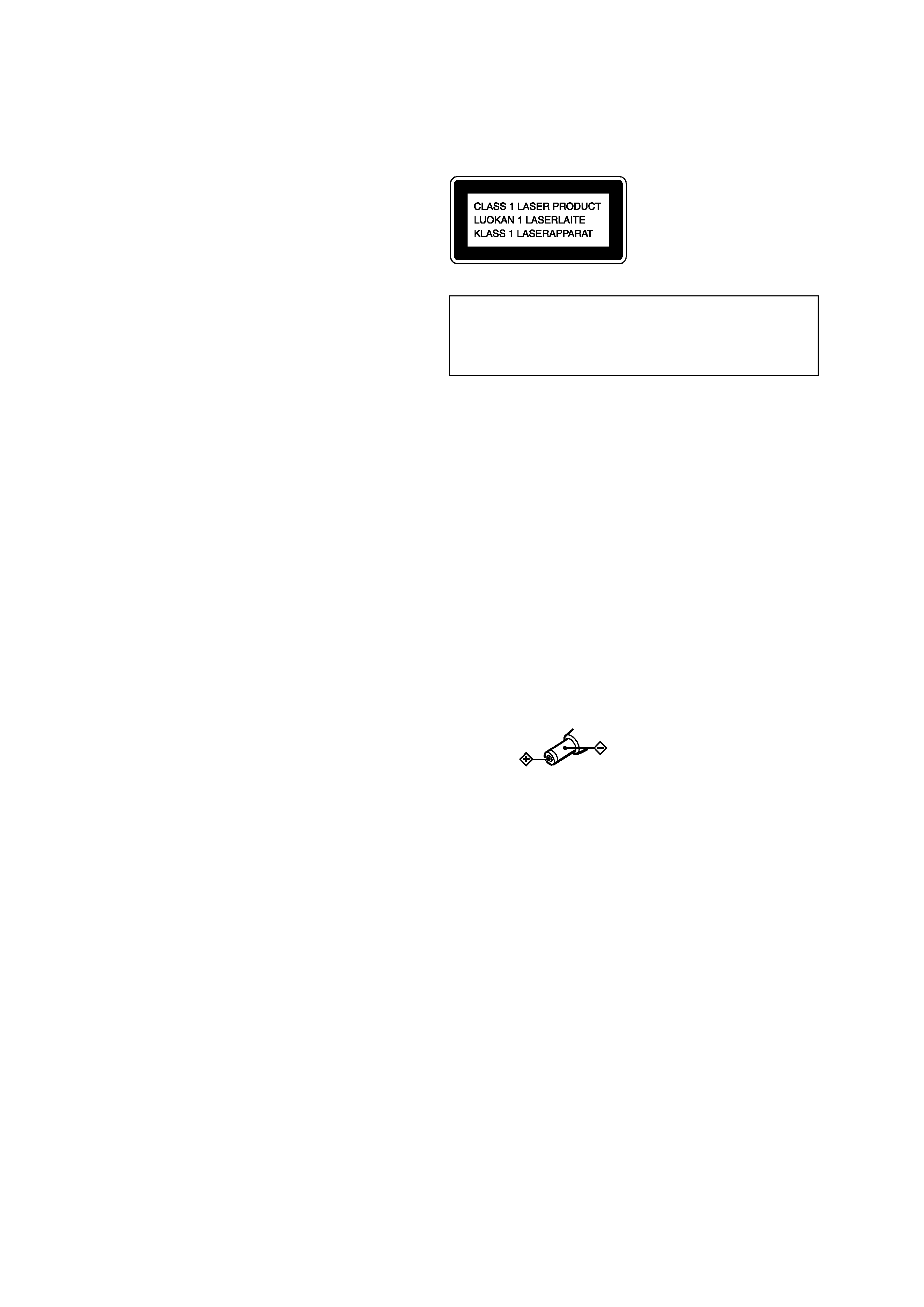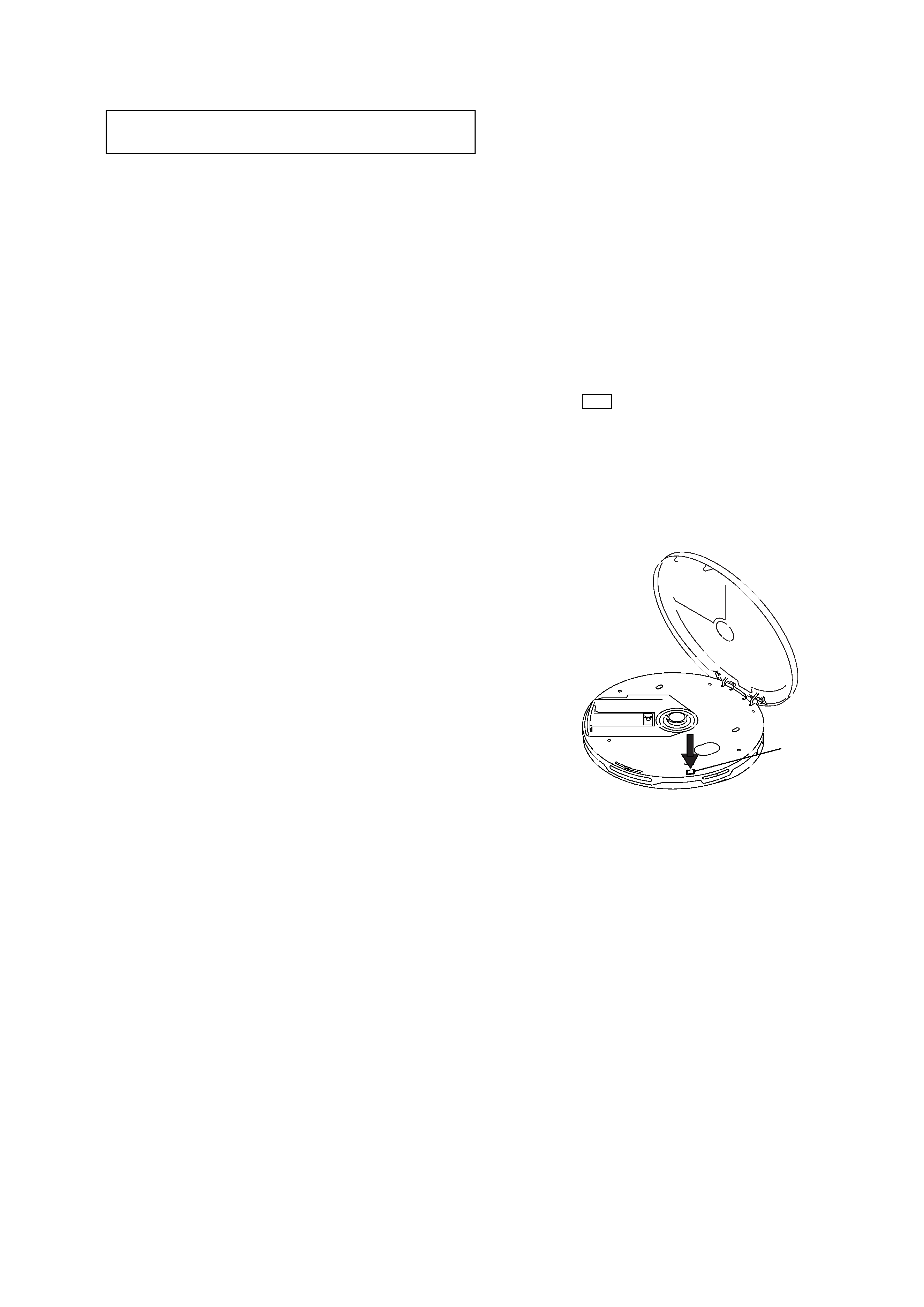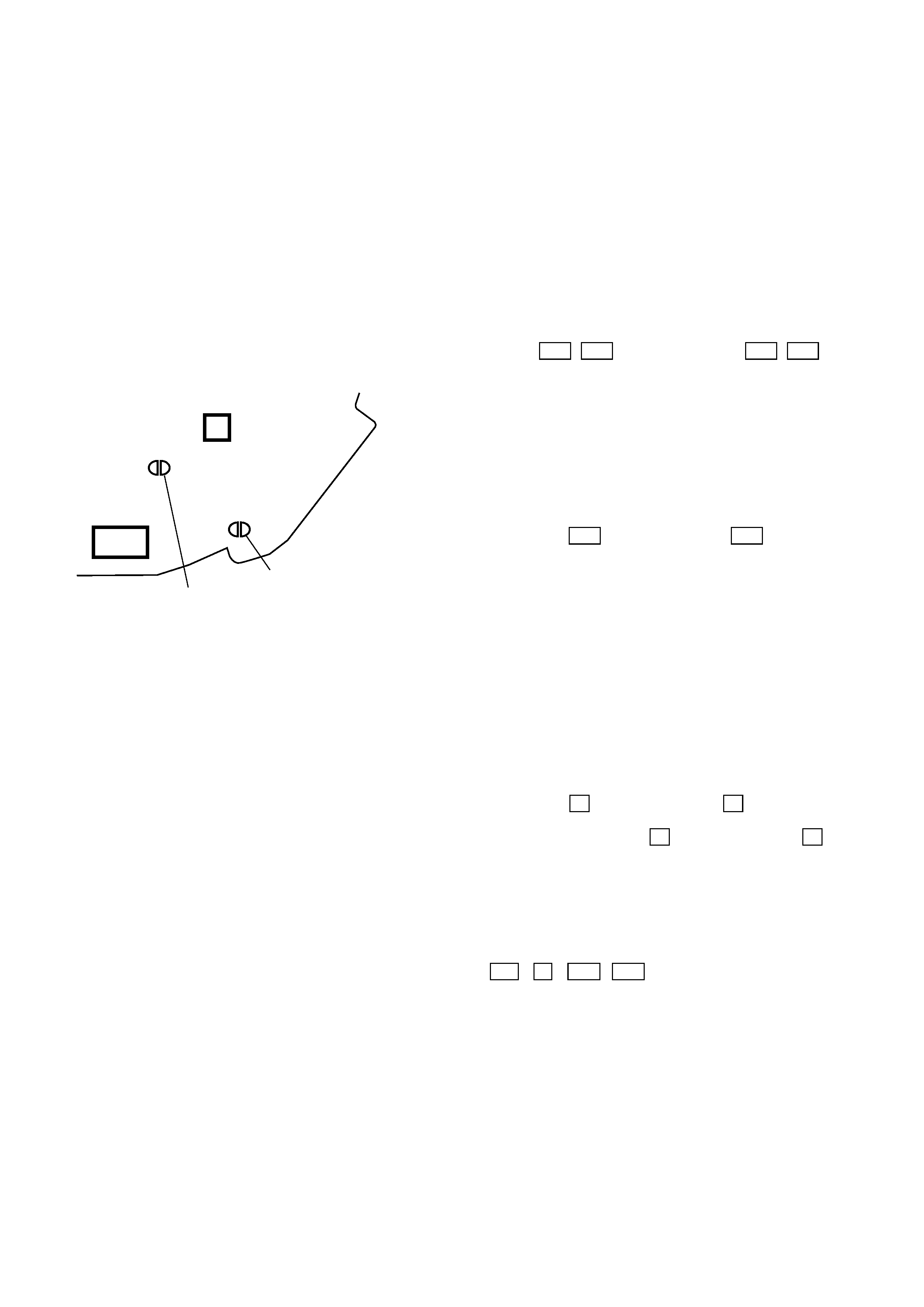
US Model
XP-ZV71/ZV71C
Canadian Model
XP-ZV77
AEP Model
XP-ZV77/ZV77D
UK Model
XP-ZV77
E Model
XP-ZV77/ZV77C/ZV77D
Australian Model
XP-ZV77
Chinese Model
XP-ZV77D
SERVICE MANUAL
PORTABLE CD PLAYER
Sony Corporation
Personal Audio Company
Published by Sony Engineering Corporation
9-877-193-03
2003H16-1
© 2003.08
SPECIFICATIONS
Ver 1.2 2003. 08
Photo : XP-ZV77
System
Compact disc digital audio system
Laser diode properties
Material: GaAlAs
Wavelength:
= 780 nm
Emission duration: Continuous
Laser output: Less than 44.6
µW
(This output is the value measured at a
distance of 200 mm from the objective lens
surface on the optical pick-up block with 7 mm
aperture.)
D-A conversion
1bit DAC
Frequency response
20 20 000 Hz
dB (measured by JEITA CP-
307)
Power requirements
· Two Ni-MH rechargeable batteries (size AA,
700 mAh): 2.4 V DC
· Two LR6 (size AA) batteries: 3 V DC
· AC power adaptor (DC IN 4.5 V jack): 120
V, 60 Hz
2
+1
Battery life* (approx. hours)
(When you use the CD player on a flat and
stable surface.)
Playing time varies depending on how the CD
player is used.
Using two Sony alkaline batteries LR6 (SG)
(produced in Japan)
EASS 1
EASS 2
Audio disc
30
26
MP3 disc
--
32
* Measured value by the standard of JEITA
(Japan electronics and Information Technology
Industries Association).
Operating temperature
5°C 35°C (41°F 95°F)
Dimensions (w/h/d) (excluding
projecting parts and controls)
Approx. 136
× 22.7 × 139 mm
(5 3/8
× 29/
32
× 5 1/
2
in.)
Mass (excluding accessories)
Approx. 222 g (7.8 oz)
Design and specifications are subject to change
without notice.
XP-ZV71/ZV71C/ZV77/
ZV77C/ZV77D
Model Name Using Similar Mechanism
D-EJ760
CD Mechanism Type
CDM-3325ER
Optical Pick-up Name
DAX-25E

2
XP-ZV71/ZV71C/ZV77/ZV77D
Flexible Circuit Board Repairing
·Keep the temperature of the soldering iron around 270 °C dur-
ing repairing.
· Do not touch the soldering iron on the same conductor of the
circuit board (within 3 times).
· Be careful not to apply force on the conductor when soldering
or unsoldering.
Notes on chip component replacement
·Never reuse a disconnected chip component.
· Notice that the minus side of a tantalum capacitor may be dam-
aged by heat.
This appliance is classified as a CLASS 1 LASER product.
The CLASS 1 LASER PRODUCT MARKING is located on
the rear exterior.
CAUTION
Use of controls or adjustments or performance of procedures
other than those specified herein may result in hazardous
radiation exposure.
On AC poweradaptor
· Use only the commercially-available AC power
adaptor whose rated output is 4.5 V DC, 500 mA.
Do not use any other AC power adaptor. It may
cause a malfunction.
Polarity of the plug
TABLE OF CONTENTS
1. SERVICING NOTE ·························································· 3
2. GENERAL ·········································································· 6
3. DISASSEMBLY ································································ 7
3-1. Lower Cabinet Section ···················································· 8
3-2. CD Mechanism Section (CDM-3325ER) ······················· 9
3-3. Cabinet (front) Sub Assy ··············································· 10
3-4. Upper Lid Sub Assy ······················································ 11
3-5. MAIN Board ································································· 12
3-6. Optical Pick-up (DAX-25E) ········································· 12
4. ELECTRICAL CHECKING ········································· 13
5. DIAGRAMS ······································································ 14
5-1. Block Diagram ······························································ 15
5-2. Printed Wiring Board MAIN Board (Side A) ········ 16
5-3. Printed Wiring Board MAIN Board (Side B) ········ 17
5-4. Printed Wiring Board LID Board ··························· 18
5-5. Schematic Diagram MAIN Board (1/4) ················· 19
5-6. Schematic Diagram MAIN Board (2/4),
LID Board ····························· 20
5-7. Schematic Diagram MAIN Board (3/4) ················· 21
5-8. Schematic Diagram MAIN Board (4/4) ················· 22
5-9. IC Block Diagrams ······················································· 23
5-10. IC Pin Function Descriptions ······································ 24
6. EXPLODED VIEWS
6-1. Cabinet (upper) Section ················································ 26
6-2. Cabinet (lower) Section ················································ 27
6-3. CD Mechanism Deck Section (CDM-3325ER) ············ 28
7. ELECTRICAL PARTS LIST ······································· 29
SAFETY-RELATED COMPONENT WARNING!!
COMPONENTS IDENTIFIED BY MARK 0 OR DOTTED LINE WITH
MARK 0 ON THE SCHEMATIC DIAGRAMS AND IN THE PARTS
LIST ARE CRITICAL TO SAFE OPERATION. REPLACE THESE
COMPONENTS WITH SONY PARTS WHOSE PART NUMBERS
APPEAR AS SHOWN IN THIS MANUAL OR IN SUPPLEMENTS
PUBLISHED BY SONY.
ATTENTION AU COMPOSANT AYANT RAPPORT
À LA SÉCURITÉ!
LES COMPOSANTS IDENTIFÉS PAR UNE MARQUE 0 SUR LES
DIAGRAMMES SCHÉMATIQUES ET LA LISTE DES PIÈCES SONT
CRITIQUES POUR LA SÉCURITÉ DE FONCTIONNEMENT. NE
REMPLACER CES COMPOSANTS QUE PAR DES PIÈSES SONY
DONT LES NUMÉROS SONT DONNÉS DANS CE MANUEL OU
DANS LES SUPPÉMENTS PUBLIÉS PAR SONY.

3
XP-ZV71/ZV71C/ZV77/ZV77D
SECTION 1
SERVICING NOTE
The laser diode in the optical pick-up block may suffer electrostatic
breakdown because of the potential difference generated by the
charged electrostatic load, etc. on clothing and the human body.
During repair, pay attention to electrostatic breakdown and also use
the procedure in the printed matter which is included in the repair
parts.
The flexible board is easily damaged and should be handled with
care.
NOTES ON LASER DIODE EMISSION CHECK
The laser beam on this model is concentrated so as to be focused on
the disc reflective surface by the objective lens in the optical pick-
up block. Therefore, when checking the laser diode emission,
observe from more than 30 cm away from the objective lens.
BEFORE REPLACING THE OPTICAL PICK-UP BLOCK
Please be sure to check thoroughly the parameters as par the "Optical
Pick-Up Block Checking Procedures" (Part No.: 9-960-027-11)
issued separately before replacing the optical pick-up block.
LASER DIODE AND FOCUS SEARCH OPERATION
CHECK
During normal operation of the equipment, emission of the laser
diode is prohibited unless the upper lid is closed while turning ON
the S301. (push switch type)
The following checking method for the laser diode is operable.
· Method:
Emission of the laser diode is visually checked.
1. Open the upper lid.
2. With a disc not set, turn on the S301 with a screwdriver having a
thin tip as shown in Fig.1.
3. Press the u button.
4. Observing the objective lens, check that the laser diode emits
light.
When the laser diode does not emit light, automatic power control
circuit or optical pickup is faulty.
In this operation, the objective lens will move up and down 4
times along with inward motion for the focus search.
NOTES ON HANDLING THE OPTICAL PICK-UP
BLOCK OR BASE UNIT
Fig. 1 Method to push the S301
S301

4
XP-ZV71/ZV71C/ZV77/ZV77D
SERVICE MODE
The following confirmation can be performed when the Service
Mode is set.
1. How to set the Service Mode.
To set the Service Mode, the following method is available.
1) Confirm the set is not powered on.
2) Confirm the following settings.
Solder Land (SL301) ................................ SHORT
[HOLD] switch (S309) ............................... OFF
3) Short the solder land SL302 (TEST) on the MAIN board.
4) Turn on the main power.
MAIN Board (SIDE A)
IC301
IC501
SL302
(TEST)
SL301
(OPEN/CLOSE)
2. Operation when the Service Mode is set.
When the Service Mode becomes active, "READING" is displayed
and then TOC of the CD is displayed.
If CD is not set, "ERROR" is displayed and LCD on the remote
control is lit off.
3. Operations by buttons or Rotary control in the
Service Mode
(Stop status)[TOC is displayed]
The following confirmations can be performed by operating
buttons(on the CD player or the remote control) or Rotary control.
· SLED Movement Mode
By pressing the > / . button on the set or the > / .
button on the remote control for few seconds, the optical pick-up is
moved to outside or inside.
(LCD display on the remote control is not changed.)
Note : Be sure to keep your eyes apart from the direct emission of
the Laser diode.
Do not move the optical pick-up over outermost or
innermost.
· CD-DA/RW Change Over Function
By short pressing the > button on the set or the > button on
the remote control, the terminal control for gain control is changed
and gain for playing of CD-DA or CD-RW is changed over.
(LCD display on the remote control is not changed.)
· Focus Search Mode
By short pressing the [VOL+] button on the set or the [VOL+] button
on the remote control, focus search is performed.
· Laser ON/OFF Selection Function
By short pressing the [VOL-] button on the set or the [VOL-] button
on the remote control, laser is switched on or off.
Note : Be sure to keep your eyes apart from the direct emission of
the Laser diode.
· Menu Mode
By short pressing the x button on the set or the x button on the
remote control, the Menu mode is activated. The menu mode is not
used for service, therefore press the x button on the set or the x
button on the remote control for short time to exit this mode. (TOC
is displayed)
4. Operations by buttons or Rotary control in the
Service Mode
(Play status)
Note : u / x / > / . buttons are available.
· Tracking/Sled Servo ON/OFF Change Over Function
By short pressing the [VOL+] button on the set or the [VOL+] button
on the remote control during play back, Tracking/Sled Servo is
switched on or off.
(Track number is displayed on the LCD display.)

5
XP-ZV71/ZV71C/ZV77/ZV77D
· Microcomputer Halt Function
By short pressing the [VOL-] button on the set or the [VOL-] button
on the remote control during play back, the operation of the
microcomputer is stopped.
After the microcomputer stopped, any key operation or display
operation is not performed. Communication with the DSP is not
performed. This mode is used only for checking the operation/
function of servo.
(LCD on the remote control is lit off)
Note : To exit this mode , switch off and then switch on.
5. How to exit the Service Mode
1)
Turn off the power.
2)
Open the solder land SL302 (TEST) on the MAIN board.
Note : The solder should be removed clean.
